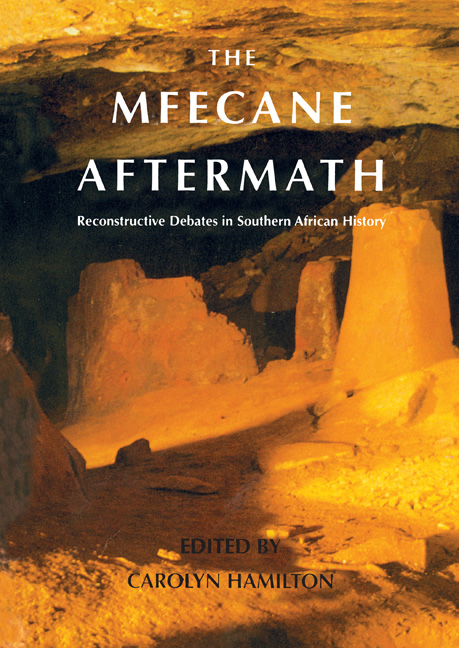Book contents
- Frontmatter
- Contents
- Maps
- Preface
- Acknowledgements
- Notes on Orthography and Names
- Contributors
- Introduction
- Part One Historiography and Methodology
- Part Two The South-Eastern Coastal Region
- Part Three The Interior
- ‘The Time of Troubles’: Difaqane in the Interior
- 11 Archaeological Indicators for Stress in the Western: Transvaal Region between the Seventeenth and Nineteenth Centuries
- 12 Prelude to Difaqane in the Interior of Southern Africa C.1600-C.1822
- 13 Conflict in the Western Highveld/Southern Kalahari c.1750-1820
- 14 ‘Hungry Wolves’: The Impact of Violence on Rolong Life, 1823-1836
- 15 The Battle of Dithakong and ‘Mfecane’ Theory
- 16 Untapped Sources: Slave Exports from Southern and Central Namibia up to c. 1850
- Glossary
- Abbreviations
- Bibliographer's Note
- Bibliography
- Complete List of Papers Presented at the Colloquium
- Index
14 - ‘Hungry Wolves’: The Impact of Violence on Rolong Life, 1823-1836
from Part Three - The Interior
Published online by Cambridge University Press: 31 May 2019
- Frontmatter
- Contents
- Maps
- Preface
- Acknowledgements
- Notes on Orthography and Names
- Contributors
- Introduction
- Part One Historiography and Methodology
- Part Two The South-Eastern Coastal Region
- Part Three The Interior
- ‘The Time of Troubles’: Difaqane in the Interior
- 11 Archaeological Indicators for Stress in the Western: Transvaal Region between the Seventeenth and Nineteenth Centuries
- 12 Prelude to Difaqane in the Interior of Southern Africa C.1600-C.1822
- 13 Conflict in the Western Highveld/Southern Kalahari c.1750-1820
- 14 ‘Hungry Wolves’: The Impact of Violence on Rolong Life, 1823-1836
- 15 The Battle of Dithakong and ‘Mfecane’ Theory
- 16 Untapped Sources: Slave Exports from Southern and Central Namibia up to c. 1850
- Glossary
- Abbreviations
- Bibliographer's Note
- Bibliography
- Complete List of Papers Presented at the Colloquium
- Index
Summary
Since the publication of John Omer-Cooper’ s The Zulu Aftermath in 1966 much has been said in textbooks and lecture theatres about the Difaqane on the highveld. Yet, despite this acclaim, so little research has been done on the subject that historians actually know very little about its dynamic or impact. They tend to describe what happened on the highveld through reference to old and very confusing military maps, criss-crossed with diverse paths of warfare. To explain the map, a confusing list of raiders’ names is usually offered, accompanied by a description of the battle of Dithakong, which is cited as a typical event of the period. Generalised comparisons are the next level of explanation. Typical of these is the claim that the Sotho were able to build confederations, while the Tswana were not - which, incidentally, is not true.
So superficial is our knowledge of the period that it quite easily lends itself to erroneous interpretations. The old myth of the ‘emptied land', although still held by arch-conservative ideologues, has long since been discredited and needs little more comment here. Similarly, the nineteenth-century notion of naked barbarism and unlimited blood-letting on the highveld has also been overthrown. Yet the ongoing silence about what actually happened on the highveld in the 1820s and 1830s and the continuing void in analysis still leads to confusion.
The latest proposition, put forward by Julian Cobbing, is that the Difaqane on the highveld did not occur at all, but was a carefully crafted myth used to cover up the violence of Cape-based slavers. Cobbing has sought to disprove the Difaqane on the highveld by discrediting contemporary missionary reports on the battle of Dithakong. His analysis, however, is highly problematic. To begin with, his reading of specific documents is biased and gravely distorts the process of historical reconstruction. He further neglects to state that the battle was part of a larger regional movement of people, witnessed and recorded by a number of Europeans and Africans.
- Type
- Chapter
- Information
- Mfecane AftermathReconstructive Debates in Southern African History, pp. 363 - 394Publisher: Wits University PressPrint publication year: 1995



